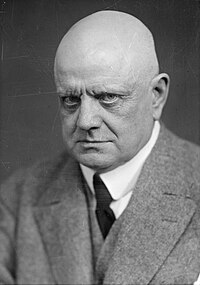Tapiola (Sibelius)
| Tapiola | |
|---|---|
| by Jean Sibelius | |
 The composer (c. 1927) | |
| Opus | 112 |
| Based on | Kalevala |
| Composed | 1926 |
| Publisher | Breitkopf & Härtel (1926)[1] |
| Duration | 18 mins.[2] |
| Premiere | |
| Date | 26 December 1926[2] |
| Location | New York City, New York |
| Conductor | Walter Damrosch |
| Performers | New York Symphony Society |
Tapiola (literal English translation: "The Realm of Tapio"), Op. 112, is a tone poem by the Finnish composer Jean Sibelius, written in 1926 on a commission from Walter Damrosch for the New York Symphony Society. Tapiola portrays Tapio, the animating forest spirit mentioned throughout the Kalevala. It was premiered by Damrosch on 26 December 1926.
History

Walter Damrosch commissioned the work for the New York Philharmonic Society. Tapiola portrays Tapio, the animating forest spirit of the Finnish forest, mentioned throughout the Kalevala.
When asked by the publisher to clarify the work's program, Sibelius responded with a prose explanation converted by his publisher (Breitkopf & Härtel) into a quatrain prefixed to English language editions of the score:
Wide-spread they stand, the Northland's dusky forests,
Ancient, mysterious, brooding savage dreams;
Within them dwells the Forest's mighty God,
And wood-sprites in the gloom weave magic secrets.
Tapiola was premiered by Walter Damrosch and the New York Symphonic Society on 26 December 1926.[3][4] The work was preceded on the program by Beethoven's Fifth Symphony, and after the interval Gershwin's Piano Concerto in F, played by the composer. Tapiola closed the concert.
The first performance in Finland on 25 April 1927 was conducted by Robert Kajanus, when the overture to The Tempest and the Seventh Symphony were also introduced to Finland. The composer Leevi Madetoja noted, "At times we hear the melancholy, repeated call of an elf, at times a lonely wanderer in the woods is giving vent to the pain of life. A beautiful work, technically close to the seventh symphony."[4]
The original publisher was Breitkopf & Härtel, who published most of the composer's works. Tapiola was Sibelius's last major work, though he lived for another thirty years. He began working on an Eighth Symphony, but he is said to have burned the sketches after becoming unhappy with the work.
Instrumentation
Tapiola is scored for the following instruments,[2] organized by family (woodwinds, brass, percussion, and strings):
- 3 flutes (the third doubling on piccolo), 2 oboes, 1 cor anglais, 2 clarinets (in A), 1 bass clarinet (in B♭), 2 bassoons, and 1 contrabassoon
- 4 horns (in E♭), 2 trumpets (in B♭), and 3 trombones
- Timpani
- Violins (I and II), violas, cellos, and double basses
Music
A typical performance of Tapiola lasts between fifteen and twenty minutes.
The opening gesture from which the whole piece develops is:
Karl Ekman wrote in the Hufvudstadsbladet: "Indeed, Tapiola is a monothematic whole – although there has been disagreement as to whether the core motif can actually be considered a theme. Erkki Salmenhaara argues that it is not. In his view, the 'core' motif gives rise to at least four central, interconnected basic motifs. These, in their turn, produce 'around thirty highly characteristic, original and inimitably Sibelian musical motifs'."[4]
Selected recordings
Kajanus, who conducted the Finnish premiere, conducted the first recording with the London Symphony Orchestra for EMI/HMV on 29 June 1932 at Abbey Road Studio 1.[5] In 1953 Herbert von Karajan conducted the Philharmonia Orchestra in the first of his four recordings of the work. (Sibelius regarded Karajan as "the only one who truly understands my work.")[6] Thomas Beecham and the Royal Philharmonic Orchestra recorded the music in 1955; it was one of the first stereophonic recordings made by EMI. Both before and since then, numerous conductors and orchestras have recorded the work.
References
- ^ Dahlström 2003, p. 472.
- ^ a b c Dahlström 2003, p. 471.
- ^ "List of Sibelius' Works of the 1920s". Retrieved 18 April 2009.
- ^ a b c "Other orchestral works / The Dryad". Tapiola. Finnish Club of Helsinki. Retrieved 8 December 2015.
- ^ Simple search for "Tapiola", CHARM Discography, Centre for the History and Analysis of Recorded Music, Arts and Humanities Research Council
- ^ BBC Radio 3's Composer of the Week program – "Sibelius – The Rest is Silence?" (17 January 2011)
Further reading
- Dahlström, Fabian [in Swedish] (2003). Jean Sibelius: Thematisch-bibliographisches Verzeichnis seiner Werke [Jean Sibelius: A Thematic Bibliographic Index of His Works] (in German). Wiesbaden: Breitkopf & Härtel. ISBN 3-7651-0333-0.
- Grimley, Daniel M. (Summer 2011). "Music, Landscape, Attunement: Listening to Sibelius's Tapiola," Journal of the American Musicological Society, vol. 64, no. 2, pp. 394–398.
- Mellers, Wilfrid (2001). "Tapiola's Search for Oneness and Cunning Little Vixen as a Parable of Redemption." In Singing in the Wilderness: Music and Ecology in the Twentieth Century (Urbana and Chicago: University of Illinois Press), pp. 37–52.
External links
- Tapiola, Op. 112: Scores at the International Music Score Library Project
- Inkpot review of Tapiola
- "December 26, 1926: The Premiere of Tapiola". Keeping Score: 13 Days When Music Changed Forever. WQXR. August 9, 2011. (audio no longer available)
- Audio on YouTube, Berlin Philharmonic, Herbert von Karajan

